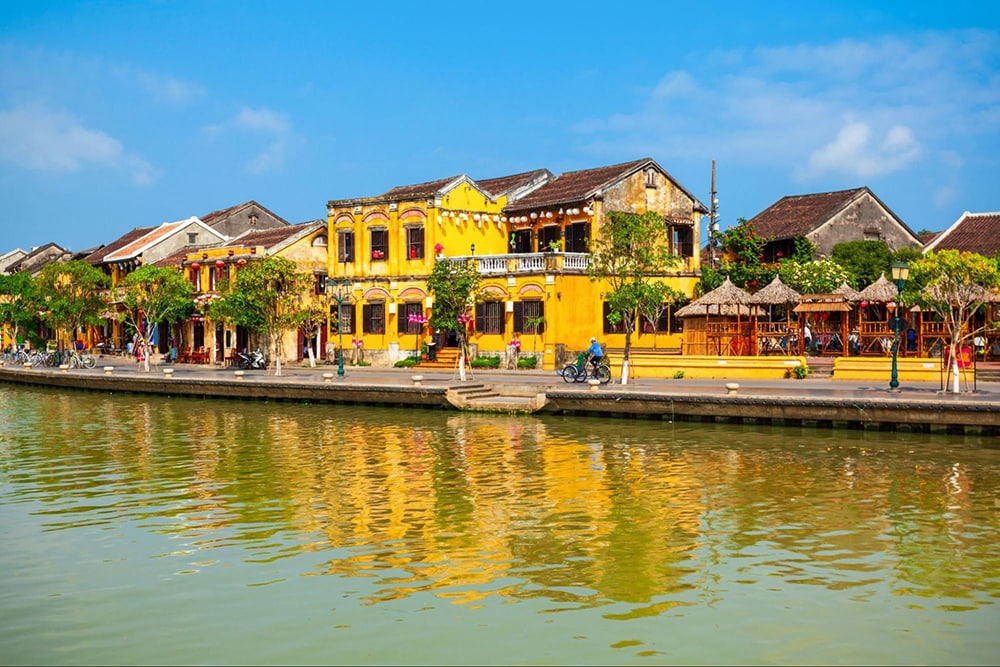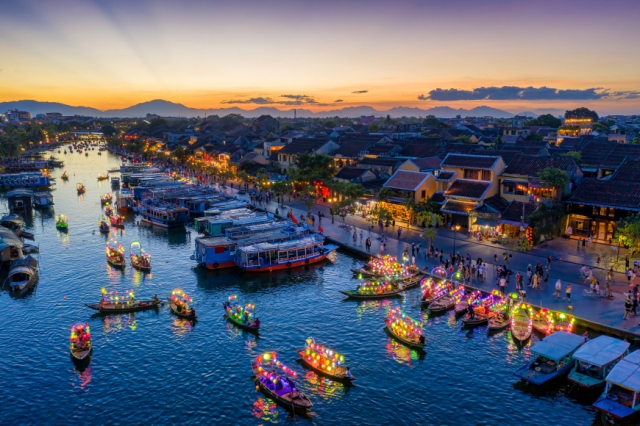Hoi An, located along Vietnam's central coast, has a well-deserved reputation as one of the country's most captivating destinations. Known for its beautifully preserved Hoi An Ancient Town, a vibrant blend of cultures, and scenic landscapes, Hoi An offers a unique combination of history, culture, and natural beauty that has made it a favorite among travelers.
Discovering Hoi An's Ancient Heritage
The soul of Hoi An lies in its Ancient Town, a UNESCO World Heritage Site filled with historical landmarks, atmospheric streets, and a diverse architectural landscape. As a former trading port dating back to the 15th century, Hoi An reflects the influence of the many cultures that once passed through, including Chinese, Japanese, and European traders.
- The Japanese Covered Bridge: One of Hoi An's most iconic landmarks, this intricately designed 18th-century bridge is both functional and symbolic, built as a gesture of friendship between Japanese and local merchants.
- Old Merchant Houses and Temples: Wander through the preserved homes, assembly halls, and temples, each showcasing traditional wooden architecture and cultural artifacts that speak to the town's multicultural heritage. The Phuc Kien Assembly Hall and Tan Ky House are among the highlights, offering glimpses into the lives of Hoi An's influential families and communities.
At night, the Ancient Town takes on a magical glow, illuminated by thousands of colorful lanterns that line the streets and float down the river. Strolling through these lantern-lit streets is one of the best things to do in Hoi An, offering a serene and picturesque experience that captures the town's enchanting atmosphere. Make sure to stop by the night market to browse for handmade souvenirs, try street food, or even create your own lantern as a keepsake. The monthly lantern festival, where locals light candles and place them in small boats on the water, is a beautiful tradition that's worth experiencing if you're in town at the right time. Additionally, consider taking a peaceful evening boat ride along the Thu Bon River, where you can set your own lantern afloat and enjoy the calming reflections on the water.

Savoring Hoi An's Culinary Scene
Hoi An is also a haven for food lovers, known for its distinctive cuisine that draws on local ingredients and influences from the region's past. Street food stalls, riverside restaurants, and traditional markets offer endless opportunities to sample the town's culinary specialties.
- Cao Lau: This signature Hoi An dish features chewy noodles, slices of savory pork, fresh herbs, and crispy croutons, all steeped in a flavorful broth made from water sourced from an ancient well. It's a dish that you'll only find here, thanks to its unique preparation method.
- Banh Mi: Hoi An has its own take on the classic Vietnamese sandwich, with a combination of meats, pickled vegetables, and homemade sauces stuffed into a freshly baked baguette. Banh Mi Phuong is a popular spot, made famous by travel shows and celebrity chefs.
- Local Delicacies: Dishes like white rose dumplings and Hoi An chicken rice highlight the town's love for fresh, flavorful, and creative cuisine. Taking a cooking class is also a rewarding way to learn about local ingredients and techniques while getting hands-on in the kitchen.
Exploring Nature and Beyond
Hoi An's natural surroundings offer plenty of outdoor activities. Rent a bicycle to explore the lush rice paddies just outside of town or take a short ride to the nearby beaches.
- Beaches: An Bang Beach and Cua Dai Beach provide a relaxing escape from the town, with soft sand and clear waters. An Bang Beach, in particular, has a laid-back vibe with several casual beachfront cafes and spots to lounge in the sun.
- Cham Islands: Just off the coast, the Cham Islands are a short boat ride away and provide opportunities for snorkeling, diving, and enjoying an island adventure. These islands are a protected marine area, known for their vibrant coral reefs and scenic beaches.
Hoiana Resort & Golf: A Modern Contrast to Hoi An
For those interested in more contemporary experiences, Hoiana Resort & Golf, offers a different facet of the region. The resort features luxury accommodations in Hoi An and a range of amenities, including an 18-hole golf course designed by renowned architect Robert Trent Jones Jr. The course takes advantage of the coastal landscape, providing a challenging yet picturesque golfing experience.
While the course and resort may appeal to golf enthusiasts and those looking for an upscale stay, it offers a counterpoint to Hoi An's more traditional and cultural attractions. Guests at Hoiana can enjoy a modern, resort-style experience while still being close enough to explore the historical charm of Hoi An.

Practical Tips for Visiting Hoi An
- Best Time to Visit: The ideal time to explore Hoi An is from February to April, when the weather is warm but not excessively hot, and the skies are clear. From September to January, the rainy season brings heavier showers that may limit outdoor activities.
- Getting Around: Hoi An is highly walkable, and many visitors choose to rent bicycles to explore both the town and surrounding countryside. Motorbikes and taxis are also readily available for getting to the beaches or nearby attractions.
- Cultural Etiquette: Be respectful when visiting religious and cultural sites. Modest dress is appreciated, especially in temples and assembly halls. Haggling is common in markets, but always approach it with a sense of humor and politeness.
The Balance of Old and New
What makes Hoi An such a compelling destination is its ability to strike a balance between preserving the past and embracing the present. The town's Ancient Quarter transports you back in time, while the surrounding area continues to evolve, offering a mix of traditional and modern experiences.
Whether you're wandering through historic alleys lit by lanterns, trying your hand at cooking Hoi An local dishes, or taking in the coastal views from a golf course, Hoi An invites you to experience a bit of everything. It's this harmonious blend of the old and the new, of culture and nature, that makes Hoi An a place that stays with you long after you leave.






